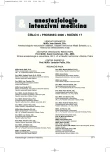Anaesthetic practice for Caesarean section in Slovakia
Authors:
P. Uharčeková 1; L. Pretiová 1; P. Uharček 2; M. Mlynček 2
Authors‘ workplace:
Klinika anesteziológie a intenzívnej medicíny, Fakultná nemocnica Nitra
1; Gynekologicko-pôrodnícka klinika, Fakultná nemocnica Nitra
2
Published in:
Anest. intenziv. Med., 17, 2006, č. 6, s. 277-280
Category:
Anaesthesiology - Original Paper
Overview
Objective:
Birth by Caesarean section is on the increase in Slovakia. General anaesthesia is used in the majority of Caesarean sections. The risk of acid aspiration and its potential development into Mendelson’s syndrome is an issue for all clinicians involved in the care of pregnant women.We conducted a retrospective study of anaesthetic practice for Caesarean section in Slovakia over a one-year period from January 1, 2005 to December 31, 2005.
Design:
A retrospective study by postal questionnaire.
Setting:
Department of Anaesthesiology and Intensive Medicine, Faculty Hospital Nitra; department of Gynaecology and Obstetrics, Faculty Hospital, Nitra.
Methods:
Anaesthetic practice for Caesarean section was assessed by a postal questionnaire sent to 66 Slovak obstetric departments.
Results:
A response rate of 92% was achieved. The 61 completed replies in this survey represented 93.3% of all Slovak deliveries in 2005. 60% of Caesarean sections were performed under general anaesthesia and 40% under regional anaesthesia. Pharmacological acid aspiration prophylaxis before Caesarean section was routinely used in 66% of departments. Intravenous H₂-blocking drugs were the most commonly used agents.
Conclusion:
According to this national survey the use of regional anaesthesia for Caesarean section is considerably less common in Slovakia than in the USA, France, the UK, Germany and other European countries. In light of the increasing rate of the Caesarean delivery, acid aspiration prophylaxis deserves more widespread attention in obstetric anaesthesia. This survey may help to initiate a discussion and to improve current anaesthetic care in obstetrics.
Key words:
anaesthesia – Caesarean section – prophylaxis – aspiration
Labels
Anaesthesiology, Resuscitation and Inten Intensive Care MedicineArticle was published in
Anaesthesiology and Intensive Care Medicine

2006 Issue 6
Most read in this issue
- Physostigmine and its place in modern anaesthesiology and intensive care
- Flumazenil – a specific antagonist of the benzodiazepines at the beginning of the 21st century. Is it needed?
- Measurement of cardiac output by the pulse contour analysis (LiDCOTM plus) and the partial rebreathing of carbon dioxide (NICO) methods – a prospective comparative study
- TOF-Watch® SX vs. Datex-Ohmeda M-NMT: A comparison of the TOF-ratio measured with accelerometry or electromyography. A clinical, prospective, controlled study.
